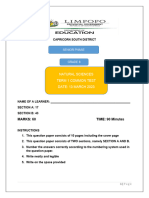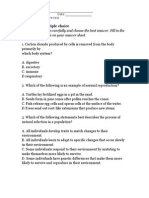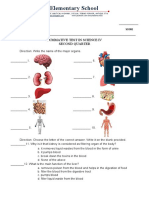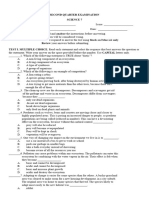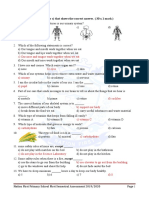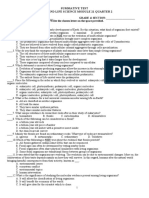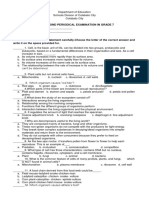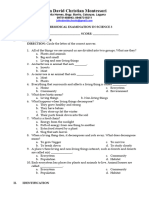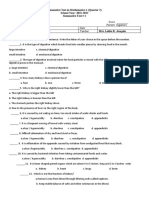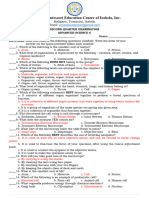D1S2_Bio_MidYear_ece3c797-4a6f-48b5-ad1a-cc2f296e0534
D1S2_Bio_MidYear_ece3c797-4a6f-48b5-ad1a-cc2f296e0534
Uploaded by
Mello MattCopyright:
Available Formats
D1S2_Bio_MidYear_ece3c797-4a6f-48b5-ad1a-cc2f296e0534
D1S2_Bio_MidYear_ece3c797-4a6f-48b5-ad1a-cc2f296e0534
Uploaded by
Mello MattCopyright
Available Formats
Share this document
Did you find this document useful?
Is this content inappropriate?
Copyright:
Available Formats
D1S2_Bio_MidYear_ece3c797-4a6f-48b5-ad1a-cc2f296e0534
D1S2_Bio_MidYear_ece3c797-4a6f-48b5-ad1a-cc2f296e0534
Uploaded by
Mello MattCopyright:
Available Formats
S2
KBTC International School
Examination and Evaluation Board
NAME
ROLL NUMBER
LEVEL
Secondary - 2
BATCH NUMBER
EXAM MID-YEAR
BIOLOGY December 2023
1 hr 30 mins
50 Marks
READ THESE INSTRUCTIONS FIRST.
Write your answers in the space provided.
Write in dark blue and black pen.
You may use an HB pencil for any lines, diagrams
or graphs.
Do not use correction fluid.
100
ANSWER ALL QUESTIONS.
Score
This document consists of (9) pages.
[1]
SECTION A
Questions 1 to 15 carry 1 mark each. For each question, the options are given. Choose the one that you
consider correct and write its letter in the space provided. (15×1 = 15 marks)
1. The diagram shows one way the body defends itself against pathogens.
What is the name of this defense mechanism?
A. antibody production
B. egestion
C. vaccination
D. phagocytosis
1.__________________
2. The diagram shows part of an alveolus and part of a nearby capillary. The arrow shows the direction
of movement of carbon dioxide and oxygen. By which process do these gases move?
A. Conduction
B. Diffusion
C. Osmosis
D. Radiation
2.__________________
3. Which iconic desert plant is commonly found in the Sonoran Desert and known for its arms that extend
upward?
A. Teddy bear cholla
B. Saguaro cactus
C. Yucca plants
D. Joshua tree
3.__________________
Secondary 2 KBTC International School
[2]
4. What is the primary concern associated with the use of DDT as an insecticide?
A. Increase plant growth
B. Improve water quality
C. Have harmful effects on non-target species and ecosystems
D. Kill mosquitoes and fleas
4.__________________
5. The diagram shows a food chain for a pond.
If a fisherman catches all the pike in the pond, which of the following would increase?
A. tadpoles only
B. perch only
C. perch and tadpoles
D. perch and pondweed
5.__________________
6. Larynx contains ____________, they are the bands of muscles.
A. Voice box
B. Rubber band
C. Vocal cord
D. Cartilage
6.__________________
7. What is the main role of decomposers in an ecosystem?
A. They produce energy through photosynthesis
B. They break down dead organisms and recycle nutrients
C. They provide food for primary consumers
D. They regulate the populations of other organisms
7.___________________
8. Lions eat antelopes. Antelopes eat plants. A lion is eating an antelope. Which of these statements
correctly describes what is taking place when a lion eats antelope?
A. carnivore is eating its prey
B. herbivore is eating its prey
C. predator is eating a carnivore
D. prey is eating a herbivore
8.__________________
Secondary 2 KBTC International School
[3]
9. What is a common pathway for the introduction of invasive species into new ecosystems?
A. Natural migration
B. Human activities
C. Climate change
D. Genetic mutations
9.___________________
10. Which substances can be broken down by decomposers?
A. Organic
B. Inorganic
C. Both A and B
D. None of the above
10.__________________
11. What is a good reason for conserving mangrove ecosystems?
A. They allow the sea easy access to the land
B. They form habitats for snakes
C. They form habitats for young fish
D. They grow at a very slow rate
11.__________________
12. Which large predator can be found in the Arctic Ocean Ecosystem?
A. A snow turtle
B. Arctic hares
C. Seal
D. Arctic crab
12.__________________
13. The colors on the ___________ show temperatures of different objects,
A. Thermostat
B. Thermometer
C. Thermogram
D. Thermogenesis
13.__________________
14. Which component of the blood carries gas for respiration?
14.__________________
Secondary 2 KBTC International School
[4]
15. An ecosystem is defined as ____________.
A. interaction between plants and animals
B. interaction between living things and physical environment
C. interaction between predators and preys
D. None of these
15._________________
SECTION B
Questions 16 to 20 carry 3 marks each. (5×3= 15 marks)
16. Complete the following sentences. [3]
(a) Some animals prefer to come out and search for food at night. Those animals are called n__________
animals.
(b) The chemicals that cannot be broken down in nature or in the bodies of organisms are termed
p__________ chemicals.
(c) The arrows in the food chain show e_________ passing from one organism to another.
17. The diagram shows a food web in an aquatic ecosystem.
(a) According to this food web, which organism is a producer?
______________________________________________________________________________[1]
(b) According to this food web, name organisms which are herbivores.
______________________________________________________________________________[1]
Secondary 2 KBTC International School
[5]
(c) Name carnivorous organisms in this food web.
______________________________________________________________________________[1]
18. Complete the following sentences with the appropriate words. [3]
When you breathe in, these things happen:
The intercostal muscles between the ribs 1(contract/relax). This pulls the ribs upwards and outwards.
The muscles in the diaphragm contract. This pulls the diaphragm 2(upwards/downwards).
These two movements increase the volume inside the 3(chest/thorax).
1.________________
2.________________
3.________________
19. Red blood cells carry oxygen to body cells for respiration. Give three reasons why red blood cells are
good at carrying oxygen.
________________________________________________________________________________
________________________________________________________________________________
______________________________________________________________________________[3]
20. Coral reefs are formed by tiny animals called coral polyps. Their hard skeletons provide many different
habitats where other species can live. One of these species is a single-celled alga that makes a toxic
substance called ciguatoxin. Herbivorous fish eat alga. Carnivorous fish eat herbivorous fish. Humans
often eat carnivorous fish.
(a) Thousands of different species live on coral reefs. Use the information to suggest why so many species
can live there.
_________________________________________________________________________________
______________________________________________________________________________[1]
(b) What is meant by a toxic substance?
______________________________________________________________________________[1]
Secondary 2 KBTC International School
[6]
(c) Use the information to construct a food chain.
______________________________________________________________________________[1]
SECTION C
Questions 21 to 24 carry 5 marks each. (5×4= 20 marks)
21. Choose the best words to complete the sentences.
antibodies bacteria carbon dioxide cytoplasm glucose haemoglobin
least like most nucleus oxygen plasma unlike
Blood contains a pale-yellow liquid, called ____(a)_____ . This liquid carries red blood cells and
white cells around the body. It also transports several different substances in solution, including
_____(b)______and _____(c) _____ . Red blood cells are the _____(d)_____ abundant cells in the
blood. Their function is to transport ______(e)_____from the lungs to all the cells in the body that
are respiring. To help them to do this, they contain a red pigment called ______(f)_______. White
blood cells, ______(g)_____red blood cells, contain a nucleus. Their function is to destroy
pathogens, such as ______(h)______, that get into the body. Some of them do this by producing
chemicals called _____(i)_______, which attach themselves to the pathogens and kill them. Other
white blood cells kill pathogens by taking them into their _____(j)_____and digesting them.
(a) ________________
(b) ________________
(c) ________________
(d) ________________
(e) ________________
(f) ________________
(g) ________________
(h) ________________
(i) ________________
(j) ________________
[5]
Secondary 2 KBTC International School
[7]
22. Brown tree snakes have caused big changes on the island of Guam. The diagram shows the food web
presents before and after the arrival of the tree snakes.
(a) State whether the numbers of the species listed below went up or down after brown tree snakes
arrived in Guam and explain each answer.
Species Up/Down Explanation
Insect-eating birds Down They are eaten by the brown tree snake.
Spiders
Bats
[4]
(b) How will the forest be affected if the insect population increases?
______________________________________________________________________________[1]
Secondary 2 KBTC International School
[8]
23. DDT is a chemical that was used by farmers to control insect pests eating their crops. It can be used to
demonstrate bioaccumulation as shown in this diagram. The concentration of DDT is shown in the
diagram in parts per million (ppm).
(a) What is DDT?
______________________________________________________________________________[1]
(b) To the nearest whole number, how many times greater is the concentration of DDT in the birds of prey
than in a sunfish?
______________________________________________________________________________[1]
(c) Explain, in your own words, why the concentration in the blue heron is greater than in a sunfish.
_________________________________________________________________________________
______________________________________________________________________________[2]
(d) What would happen to the blue heron as it accumulates DDT over its lifetime?
______________________________________________________________________________[1]
Secondary 2 KBTC International School
[9]
24. The dodo became extinct in the 17th century.
• The dodo was a flightless bird which lived on the island of Mauritius.
• The dodos built their nests on the ground.
• Dodos had never met humans before humans arrived on the island. The dodos were not afraid of the
humans.
• Humans brought new animals to the island, such as cats, dogs and rats.
• The humans removed most of the forest where the dodos lived to build new homes and to create
farmland.
(a) Write down two reasons why you think that the dodo became extinct.
________________________________________________________________________________
______________________________________________________________________________[2]
(b) Name three invasive species in this case.
______________________________________________________________________________[1]
(c) Describe two characteristics that make an invasive species successful.
_________________________________________________________________________________
______________________________________________________________________________[2]
Secondary 2 KBTC International School
You might also like
- Grade 8 Natural Sciences Common Test Term 1 Test 2023Document10 pagesGrade 8 Natural Sciences Common Test Term 1 Test 2023h76653941No ratings yet
- Grade 7 Concept TestDocument4 pagesGrade 7 Concept Testapi-334295481100% (1)
- Chapter 3 The Biosphere Test ADocument7 pagesChapter 3 The Biosphere Test ATUTORKIM100% (1)
- 6th Grade Pre-TestDocument16 pages6th Grade Pre-Testapi-251354796100% (1)
- Soil Bioeng ManualDocument99 pagesSoil Bioeng ManualJonas Kañombi MukwatuNo ratings yet
- CECS2 Bio MidYear Be9dcaa5 Bb9b 410c 98cb 7d827ffdcf4aDocument12 pagesCECS2 Bio MidYear Be9dcaa5 Bb9b 410c 98cb 7d827ffdcf4aMello MattNo ratings yet
- Preparatory Exam Nov-Dec 2023Document15 pagesPreparatory Exam Nov-Dec 2023Dr. M. Prince100% (1)
- Science 7 2nd Trime Exam (Editable PDFDocument5 pagesScience 7 2nd Trime Exam (Editable PDFFrederick EspejoNo ratings yet
- Sci 7Document4 pagesSci 7Imneil Jeanne Melendres-PerezNo ratings yet
- Second Periodical Test - Science 4Document2 pagesSecond Periodical Test - Science 4Elmalyn BernarteNo ratings yet
- Summative Test Q2Document9 pagesSummative Test Q2Jing Pelingon CartenNo ratings yet
- Science 7 2nd Summative TestDocument3 pagesScience 7 2nd Summative TestEmerlyn JosephNo ratings yet
- BIOLOGY FINAL EXAMINATIONDocument6 pagesBIOLOGY FINAL EXAMINATIONAhmed AdemNo ratings yet
- Science 4 q2matatagDocument4 pagesScience 4 q2matatagaurelia ferreraNo ratings yet
- Science 6 (FINAL Exam)Document7 pagesScience 6 (FINAL Exam)Rose Anne TorresNo ratings yet
- Validated - 2ND PT Sceince 4Document5 pagesValidated - 2ND PT Sceince 4Ronamel ToledoNo ratings yet
- Science 9 - 1qaDocument2 pagesScience 9 - 1qaSharlyn BalgoaNo ratings yet
- PT - 2ND - S7 (Revised)Document2 pagesPT - 2ND - S7 (Revised)Ica Norada TrinidadNo ratings yet
- SCIENCE 9 Pre TestDocument3 pagesSCIENCE 9 Pre TestPrincess Ann D. BajarNo ratings yet
- Ls Diagnostic Test KeyDocument7 pagesLs Diagnostic Test KeyJohn Paul BernardoNo ratings yet
- Ecology Assignment Grade - 10 A Name: - Roselyn Trixie M.Document6 pagesEcology Assignment Grade - 10 A Name: - Roselyn Trixie M.Roselyn TrixieNo ratings yet
- PCLU_SemiFInals_ExamDocument2 pagesPCLU_SemiFInals_ExamMARIZA MAPALONo ratings yet
- GRADE 10 HSB End of Year ExamDocument14 pagesGRADE 10 HSB End of Year ExamCHRISTOPHER SCALE100% (1)
- 2nd Quater Summative Test 3-4Document12 pages2nd Quater Summative Test 3-4EM GinaNo ratings yet
- PCLU Prelim Quiz1Document2 pagesPCLU Prelim Quiz1MARIZA MAPALONo ratings yet
- Baguio Patriotic High SchoolDocument4 pagesBaguio Patriotic High SchoolRyan BersaminNo ratings yet
- GEN BIO 1 1st Summative QuizDocument4 pagesGEN BIO 1 1st Summative QuizViviane O. BaylonNo ratings yet
- Earth Science Nat QDocument8 pagesEarth Science Nat QPearl Eloise BautistaNo ratings yet
- Grade 7 Test (Second Quarter)Document4 pagesGrade 7 Test (Second Quarter)Geraldine MinongNo ratings yet
- P3 Science Final Test Semester 1Document6 pagesP3 Science Final Test Semester 1Sun WilsNo ratings yet
- Summative Test Ecosystem 1Document1 pageSummative Test Ecosystem 1Jonalvin KE67% (3)
- Mid-Year 2012 Exam - Form 2 - Science - Paper 1Document7 pagesMid-Year 2012 Exam - Form 2 - Science - Paper 1Noor Fauzana RahmatNo ratings yet
- 7 083422 Worksheet11grade7Document6 pages7 083422 Worksheet11grade7Saima MohammedNo ratings yet
- 2nd Periodical Test Science 4 SY 2022 2023Document5 pages2nd Periodical Test Science 4 SY 2022 2023KRISTINE JOAN BARREDO100% (4)
- Digestive System ExamDocument3 pagesDigestive System ExamRouse Leanne NicolasNo ratings yet
- 2nd PeriodicalDocument4 pages2nd PeriodicalZaina SarcosNo ratings yet
- D1S1 Bio MidYearDocument11 pagesD1S1 Bio MidYearkyawzinlin7790No ratings yet
- Full English Secondary Semester Two Examinations (ONLINE) Jubilee School 2020 7 A/B/C BiologyDocument13 pagesFull English Secondary Semester Two Examinations (ONLINE) Jubilee School 2020 7 A/B/C BiologyIndra PurnamaNo ratings yet
- GEN BIO 1 1st Qrter ExamDocument4 pagesGEN BIO 1 1st Qrter ExamViviane O. BaylonNo ratings yet
- S10 Q3 Enhanced Hybrid Module 7 Week 7 FinalDocument16 pagesS10 Q3 Enhanced Hybrid Module 7 Week 7 FinallegnaorelotsapNo ratings yet
- Earth Ad Life Exam 2Document3 pagesEarth Ad Life Exam 2lvpetlungay100% (1)
- Grade 9 Test (March 2023)Document5 pagesGrade 9 Test (March 2023)Tan TaylorNo ratings yet
- Summative Test Earth and Life Science Module 21 Quarter 2Document5 pagesSummative Test Earth and Life Science Module 21 Quarter 2Mira Lei Marigmen100% (1)
- SECOND PRELIMS Examination in Earth and Life Science 11Document3 pagesSECOND PRELIMS Examination in Earth and Life Science 11Apple SyNo ratings yet
- Interaction of Organism WorksheetDocument4 pagesInteraction of Organism Worksheetsalianhrishika181108No ratings yet
- Second Quarter Periodic Test 2022 2023Document6 pagesSecond Quarter Periodic Test 2022 2023Rusthel Joyce MataNo ratings yet
- Second Periodical ExaminationDocument4 pagesSecond Periodical ExaminationKhalilNo ratings yet
- Third Periodical Examination in Science 3Document2 pagesThird Periodical Examination in Science 3Jan Ira RenolayanNo ratings yet
- Bio PracticeDocument6 pagesBio Practice4b00d1No ratings yet
- SCIENCE 4 Q2 QuizDocument11 pagesSCIENCE 4 Q2 QuizJiro SarioNo ratings yet
- 2ND Periodical Test ScienceDocument4 pages2ND Periodical Test Sciencej17420538No ratings yet
- Summative ExamDocument4 pagesSummative Examapi-635545512No ratings yet
- PT - Science 4 - Q2Document6 pagesPT - Science 4 - Q2Kalea Kassandra MatthewsNo ratings yet
- Second QuarterDocument3 pagesSecond QuarterShaikha Rose A. CacabilosNo ratings yet
- 2nd Periodical Test in Science 6Document6 pages2nd Periodical Test in Science 6Jonniza AlbitNo ratings yet
- last-quarterly-examination-in-Earth-and-Life-Science 2nd Q.Document6 pageslast-quarterly-examination-in-Earth-and-Life-Science 2nd Q.Marina AbanNo ratings yet
- Science Class 7 Habitats and Food ChainsDocument6 pagesScience Class 7 Habitats and Food ChainsMuhammad Asim RazaNo ratings yet
- BSA FinalExamDocument2 pagesBSA FinalExamjimboysapal9No ratings yet
- Exam 4th Grade 8Document4 pagesExam 4th Grade 8CharizNo ratings yet
- Q1exam Grade9Document5 pagesQ1exam Grade9Imneil Jeanne PerezNo ratings yet
- O Level Biology Practice Questions And Answers: Ecology And Our Impact On The EcosystemFrom EverandO Level Biology Practice Questions And Answers: Ecology And Our Impact On The EcosystemNo ratings yet
- National Human Wildlife Conflict Mitigation Strategy and Action Plan of India 2Document144 pagesNational Human Wildlife Conflict Mitigation Strategy and Action Plan of India 2Amruth MangalNo ratings yet
- Principles of Termite Proofing - BCM SeminarDocument17 pagesPrinciples of Termite Proofing - BCM Seminarapi-199157310% (1)
- Environmental Issues of The GalapagosDocument2 pagesEnvironmental Issues of The GalapagosJohn OsborneNo ratings yet
- Advances in Landscape Architecture PDFDocument938 pagesAdvances in Landscape Architecture PDFskilmag100% (4)
- Spanish Ceramic Tiles BookletDocument6 pagesSpanish Ceramic Tiles Bookletapi-301433196No ratings yet
- NGO Working For Sustainble Community Growth - Lovely FoundationDocument7 pagesNGO Working For Sustainble Community Growth - Lovely FoundationLovely FoundationNo ratings yet
- Stream Restoration Case Studies 160Document188 pagesStream Restoration Case Studies 160sourloulouNo ratings yet
- Natural Science AssignmentDocument11 pagesNatural Science AssignmentPartz MatsuzawaNo ratings yet
- Abdullah, Idris, Saparon - 2017 - Papr Reduction Using SCS-SLM Technique in STFBC Mimo-OfdmDocument10 pagesAbdullah, Idris, Saparon - 2017 - Papr Reduction Using SCS-SLM Technique in STFBC Mimo-OfdmImanol O'ConnorNo ratings yet
- Ecological EnergeticsDocument4 pagesEcological EnergeticsHaris KhanNo ratings yet
- Public Interest Litigation (Pil) No. 20 April of 2024 in The High Court of Uttarakhand at NainitalDocument3 pagesPublic Interest Litigation (Pil) No. 20 April of 2024 in The High Court of Uttarakhand at NainitalSujata KumariNo ratings yet
- BobwhiteDocument1 pageBobwhiteapi-379174072No ratings yet
- Environmental Science and Engineering - 2 - 1725256942349Document16 pagesEnvironmental Science and Engineering - 2 - 1725256942349shrawanichougule18No ratings yet
- Ecology Project Presentation ScriptDocument2 pagesEcology Project Presentation Scriptapi-347575155No ratings yet
- International Drive SettlementDocument8 pagesInternational Drive SettlementABC15 NewsNo ratings yet
- Critical Evaluation and Promotion of Indigenous PracticesDocument18 pagesCritical Evaluation and Promotion of Indigenous PracticesZnyx Aleli Jazmin-MarianoNo ratings yet
- Bantu MigrationsDocument2 pagesBantu Migrationskinneyjeffrey100% (1)
- Kilima BrochureDocument15 pagesKilima Brochurevii.camargo07No ratings yet
- Department of Environment and Natural ResourcesDocument17 pagesDepartment of Environment and Natural ResourcesKaren de LeonNo ratings yet
- UPSC Civil Services Examination SyllabusDocument150 pagesUPSC Civil Services Examination SyllabusAbhishek KarshNo ratings yet
- Course Work ElpDocument31 pagesCourse Work ElpMuhammad NazrinNo ratings yet
- The Power of NatureDocument2 pagesThe Power of NatureyowNo ratings yet
- Spinning Assignment.1Document10 pagesSpinning Assignment.1fani7455729No ratings yet
- L01.Environment - Climate ChangeDocument65 pagesL01.Environment - Climate ChangeSRIJANo ratings yet
- Introduction To EcologyDocument34 pagesIntroduction To EcologyLove Love100% (1)
- Grade 8 Agriculture Notes Term 1Document12 pagesGrade 8 Agriculture Notes Term 1DEBUKXGRAPHICS ENTERPRISENo ratings yet
- Carmona Et Al. 2013 - BiolConsDocument8 pagesCarmona Et Al. 2013 - BiolConsCarlos Pérez CarmonaNo ratings yet
- Sat Practice Test 2 Writing and Language Assistive TechnologyDocument88 pagesSat Practice Test 2 Writing and Language Assistive TechnologyAgungdeAngeloNo ratings yet
- Pp. 21-50Document34 pagesPp. 21-50EssamradwanNo ratings yet
